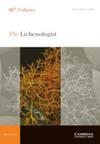在意大利各保护区对地衣的物种-地区关系进行了测试
IF 1.4
4区 生物学
Q4 MYCOLOGY
引用次数: 0
摘要
物种-面积关系(SAR)表明物种丰富度随采样面积的增加而增加,但其他因素也会影响这一格局。SARs已经在许多不同的生物体上进行了测试,但很少在地衣上进行测试。我们的目标是在广泛的面积范围内测试地衣的SAR,用于三种主要的与基质相关的地衣行业,即附生地衣、附生地衣和附生地衣。该测试使用的数据来自意大利44个不同大小的保护区的地衣清单。结果表明,三种地衣的物种丰富度均与面积大小呈正相关,且对附生地衣的对数函数和对附生地衣和附生地衣的幂函数拟合较好。我们的研究结果支持了区域大小作为地衣多样性的主要驱动因素的基本作用,这表明在基于区域的保护框架中,更大的保护区是支持高地衣物种丰富度的基础。然而,还需要更精细的调查来更好地阐明其他环境因素是否以及如何与面积大小相互作用并改变SAR模式。详尽的地衣清单可能是有用的信息来源,可以更有力地测试这种关系,从而更好地为保护实践提供信息。本文章由计算机程序翻译,如有差异,请以英文原文为准。
Species–area relationship in lichens tested in protected areas across Italy
Abstract The species–area relationship (SAR) states that species richness increases with the increase of the sampled area, although other factors can influence the pattern. SARs have been tested on many different organisms, but only rarely on lichens. We aimed to test the SAR, across a wide range of area sizes, for three main substratum-related guilds of lichens, namely epiphytic, epilithic and epigaeic. The test was performed using data from lichen inventories carried out in 44 protected areas of various sizes across Italy. We found a positive correlation of species richness with area size for all three guilds, better fitted by the logarithmic function for epilithic lichens and by the power function for epiphytic and epigaeic lichens. Our results support the fundamental role of area size as the main driver for lichen diversity, suggesting that in an area-based conservation framework, larger protected areas are fundamental to support high lichen species richness. However, finer scale investigations are also required to better elucidate whether and how other environmental factors could interact with area size and modify SAR patterns. Exhaustive lichen inventories could be useful information sources to more robustly test such relationships, and therefore better inform conservation practices.
求助全文
通过发布文献求助,成功后即可免费获取论文全文。
去求助
来源期刊

Lichenologist
生物-真菌学
CiteScore
2.90
自引率
14.30%
发文量
23
审稿时长
6.0 months
期刊介绍:
The Lichenologist is the premier scientific journal devoted exclusively to the study of lichens worldwide. As the leading forum for the dissemination of new concepts and topical reviews, The Lichenologist reaches more scientists concerned with the study of lichens and lichen symbionts than any other single journal. All aspects of lichenology are considered including systematics and phylogenetics; molecular biology; ultrastructure, anatomy and morphology; secondary chemistry, effects of pollutants and use as bioindicators; biogeography. In addition to standard length research papers, the journal also publishes Short Communications and Book Reviews. A monthly issue may occasionally be devoted to papers deriving from a symposium.
 求助内容:
求助内容: 应助结果提醒方式:
应助结果提醒方式:


